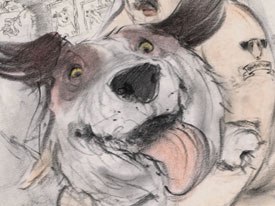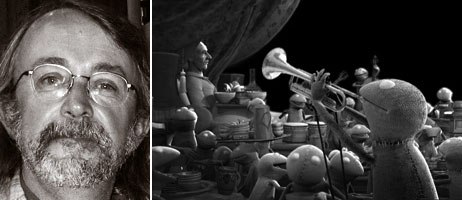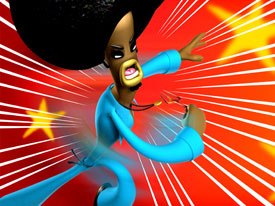Andrew Osmond encounters more than just animated encounters in Bristol this year, as Encounters 2006 showcases both animation and live-action.

Chris Shepherd's Silence is Golden, a hybrid of animation and live action, dominated the animated films at Encounters. © Slinky Pictures 2006.
In recent years, the Watershed Centre in Bristol has hosted five highly popular Animated Encounters festivals. The length and format of the event has changed each time, though it has always kept the distinctive Desert Island Flicks item where animation luminaries ranging from Matt Groening to Jeffery Katzenberg choose their favorite cartoons. This year, in a particularly bold experiment, the Watershed merged the animation event with its previously distinct Encounters festival, which showcases live-action short films.
While it may have been done for practical and logistical reasons, the move implicitly reminds us of the arbitrary ways in which we classify screen media. Is a filmmaker who's creating an eight-minute family drama in 2D animation nearer to a model animator who's making a TV commercial with plasticine characters, or to the director of a short live-action documentary film? Is the fuzzily-defined animation medium, a more "important" category than the short-film format?
Certainly, one of the guests at the festival, was enthusiastic about the festival's move toward a more hybridized media. His own new film, the 15-minute Silence is Golden, is a predominantly live-action drama, but it uses animation to help convey emotions and fantasies, useful when the main character is a not especially nice little boy.
Several of the Encounters screening programs mixed in animated works with what were often more "cartoonish" live-action offerings. The festival's main guest was the enfant terrible British director Ken Russell, best known for the scandalous 1970s religious melodrama, The Devils, but also responsible for many experimental live-action shorts. The downside was that if you were interested in animation, rather than in short films, then the festival was effectively truncated to an "Animation Industry Day" in the middle of the week, a day where you had to choose between parallel strands of interesting-looking items. Maybe that was enough for the attendees, all of whom seemed impressed as usual with the caliber of talks and guests. Perhaps, indeed, the broader media perspective worked to bring people out of the tunnel vision of what professionals sometimes ruefully call "animator land." It'll certainly be interesting to see what the Watershed decides to program next year.

After its triple win at Annecy earlier this year for Dreams and Desires -- Family Ties, Joanna Quinn and partner Les Mills were frank about their strengths and weakness during an informal talk. © Beryl Prods. International Ltd.
Of the Industry Day events that fall into animation interests, I saw a morning presentation by Joanna Quinn and her partner Les Mills of the Welsh studio Beryl Prods. The company is very much in the industry eye at the moment after its triple Annecy win for Dreams and Desires -- Family Ties earlier this year. In a relaxed, informal talk, Quinn and Mills were surprisingly frank about their different strengths and weaknesses, and their points of disagreement (Mills, we learned, was particularly disappointed by the "dumpy mongrel" dog who plays a big part in Family Ties). Otherwise, the presentation was a highly enjoyable account of Beryl Prods.' evolution and its working style.
Quinn is a strong believer in the swiftly drawn, thumbnail sketches, which capture the essence of a drawn image and can still be guides weeks or months into laborious production. Keeping this point in mind, Quinn took us through the making of one of Beryl Prods.' long series of Charmin toilet-paper commercials, in which members of the animal kingdom lyrically adore the soft brand product. (By the way, Beryl Prods. also created the popular Whiskas TV commercials featuring a pair of sleek fat cats, Marvin and Chuck.) We also saw development sketches from the next Dreams and Desires film, Beverly Thrills, which will be an intimate portrait of heroine Beverly's alarming sister. "So far, Family Ties has been successful," said Mills modestly. "But no one else has put money in yet!"
At the other end of the day, Shepherd was on hand to take us through the films he has directed or overseen. It amounted to a powerful, pungent body of work, even if you already knew his most famous films -- the ferociously angry Dad's Dead (which once led to Shepherd being verbally abused outside a genteel London arts cinema) and, more recently, Who I Am and What I Want (created with artist David Shrigley) and Silence is Golden. Shepherd's earlier films included The Broken Jaw, a vision of karaoke for winos; the TV sketch "Stereout Final," whose title tells you the joke; and Pop Skool: Ice T, a unique account of the life and death of Princess Diana, which managed to shock even this jaded Spike and Mike viewer. Shepherd's first animation was a real gem, a super 8, plasticine film called, Safari, in which blob creatures eat each other with vibrantly, energetic abandon.

Surprisingly, Peter Lord didn't pick any plasticine films for his Desert Island list, but he did choose acclaimed Overtime among his Top 10 titles. © Premium Films.
Plasticine, surprisingly, didn't figure in any of the "Desert Island" choices of Aardman co-founder Peter Lord, or Peter Lord CBE as he should properly be called now. (Lord joked that he was easily pleased.) It was Lord's turn this year to decide which films he'd choose to be cast away with on a desert island. Several of his picks were stop motion, including Ray Harryhausen's skeleton fight in Jason and the Argonauts, the satanic bar scene in Lladislas Starevich's 1930s short, The Mascot and George Pal's Puppetoon pirate adventure, What Ho She Bumps. Another of Lord's picks was the Quay Brothers' feted if esoteric Street of Crocodiles. Lord admitted that when he first saw the Quays' film, he was annoyed by it being so outrageously enigmatic. He was, as he put it, a "very literal-minded person," but, at the same time, he was awed by the film's beauty, "one terrific image after another."
Lord's other picks included Chuck Jones' Duck Amuck (which Lord paid homage to in his own stop-motion Adam), Hayao Miyazaki's My Neighbor Totoro, Brad Bird's The Incredibles and the "Itchy and Scratchy and Poochie" episode of The Simpsons. The last selections were two recent shorts, Aardman's 2D The Adventures of Big Jeff (starring "the Aussie with no cossie") and the acclaimed French CGI Overtime. Aardman's own CGI film, Flushed Away, was screened at Encounters the next day, timed to coincide with the London premiere across the country. Lord, however, assured the audience that 50 of the Aardman studio's animators were busy moving bits of plasticine around, just as he and David Sproxton had been doing as industrious schoolboys 30 years earlier.

Cartoon Network detailed its plans to open a new development studio in Soho. It also publicized Aardman's much-awaited CGI sketch show for the channel, Chop Socky Chooks. Courtesy of Cartoon Network.
Of the more industry-oriented events, I sat in at "Agencies and Animation." Among other things, the panel reminded us never to overestimate a client's understanding of the animation process, especially when planning a multi-platform campaign. Partly for this reason, there still seems to be a question mark over what part animation can play in new marketing forms, such as viral advertising.
Another panel, "Creating a Brand," featured the man who should know more about brands than anyone else, Bob the Builder creator Keith Chapman. However, one still got the feeling that creating a brand was the art of bottling lightning, though Chapman said interesting things about how Bob found himself competing for broadcasters with Jim Henson's "Construction Site" -- a series with some of the same ideas, but crucially lacking human characters.
I wasn't able to see the "Feature Film" panel, which played opposite the Joanna Quinn event, but from what I heard it was a highly informative discussion, bringing together the perspectives of big studios and independent producers. Another item I was sorry to miss (being in the middle of an in-depth discussion with Shepherd about the vintage British TV referenced in his films, and Doctor Who in particular) was the Cartoon Network event. This detailed the company's plans to open a new development studio in Soho, located in the middle of London's West End. Soho is a familiar address for British animators, as it's the locale of many famed animation outfits past and present. The Cartoon Network event also publicized Aardman's much-awaited CGI sketch show for the channel, Chop Socky Chooks.
The animated films at Encounters were dominated by Shepherd's Silence is Golden, which really does need to be seen on the big screen, and is everything that you would expect from a director of Shepherd's class. As an SF fan, I liked Raphael Wahl's wry German space adventure X, as well as Ian Gouldstone's more down-to-earth cautionary tale of casual encounters, Guy 101. Other films at the festival used interesting splices of animated materials, such as the model/drawn Dragon by America's Troy Morgan.
As is so often the case, though, these films often felt technically accomplished rather than emotionally compelling for the animation layman. Maybe for this reason alone, the cross-fertilizing of live-action and animated works in this year's Encounters is an experiment worth repeating in the future.
Andrew Osmond is a freelance writer specializing in fantasy media and animation.







